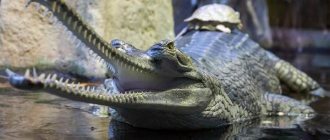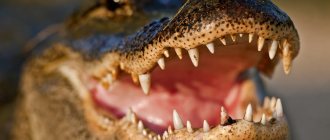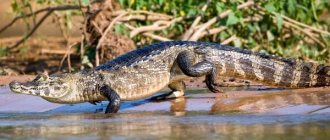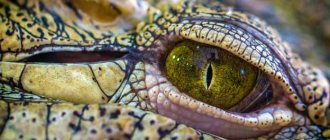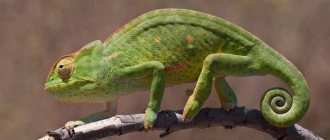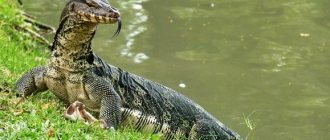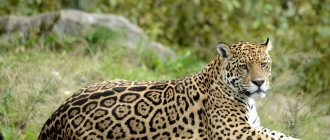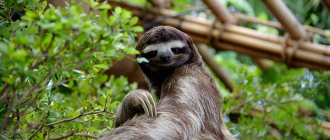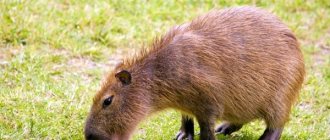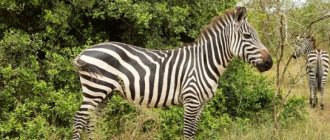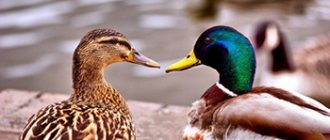Features and habitat of the crocodile
Life in water has formed the corresponding body of a reptile: the body of crocodiles is long, almost flat, with a flat long head, a powerful tail, short paws with toes connected by membranes.
The crocodile is a cold-blooded animal , its body temperature is about 30 degrees, sometimes it can reach 34 degrees, it depends on the ambient temperature. The fauna of crocodiles is very diverse, but the species differ only in the long body; there are reptiles up to 6 meters, but most are 2-4 m.
The largest saltwater crocodiles weigh more than a ton and have a length of up to 6.5 m, they are found in the Philippines. The smallest land crocodiles, 1.5-2 m, live in Africa. Under water, the crocodile's ears and nostrils close with valves, transparent eyelids fall over the eyes, thanks to them the animal sees well even in muddy water.
The mouth of crocodiles does not have lips, so it does not close tightly. To prevent water from entering the stomach, the entrance to the esophagus is blocked by the velum palatine. The crocodile's eyes are located high on the head, so only the eyes and nostrils are visible above the surface of the water. The brown-green color of the crocodile camouflages it well in the water.
The green tint predominates if the ambient temperature is elevated. The animal's skin consists of durable horny plates that protect the internal organs well.
Crocodiles, unlike other reptiles, do not shed; their skin constantly grows and renews itself. Thanks to its elongated body, the animal maneuvers well and moves quickly in the water, while using its powerful tail as a rudder.
Crocodiles live in fresh waters of the tropics. There are species of crocodiles that are well adapted to salt water; they are found in the coastal strip of the seas - these are combed, Nile, and African narrow-snouted crocodiles.
Differences from amphibians
The question often arises whether a crocodile is an amphibian or a reptile. Any experienced biologist will tell you that these large predators belong exclusively to the class of reptiles, like various lizards, turtles and snakes. The crocodile differs from amphibians in the absence of two stages of development and the presence of a strong skeleton, which makes this animal a dangerous predator. Like all reptiles, it is cold-blooded, so it often needs to bask in the sun, thereby regulating its body temperature.
Another important difference from amphibians is the presence of cervical vertebrae, which allow this animal to quickly turn its head while maintaining a constant body position. These reptiles do not have pronounced cutaneous respiration, so they use their nostrils, and at the same time they are able to retain air in their lungs for 30 minutes or more while being at the bottom under water. Like all reptiles, in crocodiles, fertilization of eggs occurs inside the body, and the cubs are born fully formed, but at the same time they need the protection of an adult mother for some time.
Character and lifestyle of a crocodile
Crocodiles are almost constantly in the water. They crawl ashore in the morning and evening to warm their horny plates in the sun. When the sun is hot, the animal opens its mouth wide, thus cooling the body.
Birds, attracted by leftover food, can freely enter the mouth at this time to eat. And although the crocodile is a predator, a wild animal, it never tries to grab them.
Crocodiles mainly live in fresh waters; in hot weather, when the reservoir dries out, they can dig a hole at the bottom of the remaining puddle and hibernate. During drought, reptiles can crawl into caves in search of water. If hungry, crocodiles are able to eat their relatives.
On land, animals are very clumsy and clumsy, but in water they move easily and gracefully. If necessary, they can move to other bodies of water by land, covering several kilometers.
Law of the jungle
Despite such guardianship, the list of those wishing to feast on the delicious meat is quite large. Newborn crocodiles are hunted by many predatory mammals, birds, and reptiles. Often, crocodiles themselves eat the cubs of their own tribesmen. The survival rate is low: only one individual in a hundred reaches maturity.
But such a harsh law of the jungle probably determines the power and strength of an adult animal. After all, every crocodile has overcome the most difficult path in the struggle for its own life.
Nutrition
Crocodiles hunt mainly at night, but if prey is available during the day, the animal will not refuse to feast on it. Receptors located on the jaws help reptiles detect potential prey even at a very long distance.
The main food of crocodiles is fish, as well as small animals. The choice of food depends on the size and age of the crocodile: young individuals prefer invertebrates, fish, amphibians, adults prefer small mammals, reptiles and birds.
Very large crocodiles can easily handle victims larger than themselves. This is how Nile crocodiles hunt wildebeest during their migration; the saltwater crocodile hunts livestock during the rains; Madagascar can even feed on lemurs.
Reptiles do not chew food; they tear it into pieces with their teeth and swallow them whole. They can leave prey that is too large at the bottom to soak. Stones swallowed by animals help in digesting food; they crush it in the stomach. Stones can be of impressive size: a Nile crocodile can swallow a stone up to 5 kg.
Crocodiles do not eat carrion unless they are very weak and unable to hunt; they do not touch rotten food at all. Reptiles eat quite a lot: they can consume about a quarter of their weight in food at a time. About 60% of the food consumed turns into fat, so the crocodile can fast for up to one year if necessary.
Name
Let's start with the simplest. Do you know what a baby crocodile is called? Note that a special name for newborns and young animals does not always exist. If in doubt, it is better not to invent words, but to make do with the “baby”.
Modern dictionaries and reference books advise using the word “little crocodile” exclusively in oral speech. For writing, simply “baby”, “crocodile” or “little crocodile” is more suitable.
Reproduction and lifespan
The crocodile is a long-lived animal ; it lives from 55 to 115 years. Puberty occurs early, at approximately the age of 7 - 11 years. Crocodiles are polygamous animals: a male has 10 - 12 females in his harem.
Although the animals live in water, they lay eggs on land. At night, the female digs a hole in the sand and lays about 50 eggs there, covering them with leaves or sand. The size of the depression depends on the illumination of the place: in the sun the hole becomes deeper, in the shade it is not very deep.
The eggs mature for about three months, during which time the female remains close to the clutch, practically not feeding. The sex of future crocodiles depends on the environmental temperature: females appear at 28-30° C, males at temperatures above 32° C.
Before they are born, the babies inside the eggs begin to grunt. The mother, hearing the sounds, begins to dig out the masonry. Then he helps the babies free themselves from the shell by rolling the eggs in their mouths.
The female carefully transfers the emerging crocodiles, measuring 26-28 cm, into a shallow body of water, capturing them in her mouth. There they grow for two months, after which they disperse to the surrounding, not heavily populated, reservoirs. Many small reptiles die, they become victims of birds, monitor lizards and other predators.
Surviving crocodiles first feed on insects, then hunt small fish and frogs, and from the age of 8-10 years they begin to catch larger animals.
Not all types of crocodiles . So the Nile crocodile and the saltwater crocodile are cannibals, but the gharial is not at all dangerous. crocodile is kept as a pet even in city apartments.
In their habitats, crocodiles are hunted, their meat is eaten, and their skin is used to create haberdashery, which has led to a decline in the crocodile population. In some countries today they are bred on farms; many tribes consider the crocodile a sacred animal.
Impact on the ecosystem
In the 20th century, the fashion for crocodile skin, which has not passed to this day, led to the mass extermination of reptiles. Some species of crocodiles are on the verge of extinction, namely:
- Nile;
- Siamese;
- Thin-winged.
In the USA, about 50 thousand reptiles were exterminated annually. As a result, authorities took protective measures to prevent the species from becoming extinct.
Scientists have proven that crocodiles play a vital role in the ecosystem. For example, an outbreak of malaria in Africa occurred due to the extermination of Nile crocodiles, which regulated the number of cichlids that fed on carp fish species. The carp, in turn, destroyed the mosquito larvae. In the absence of crocodiles, cichlids proliferated excessively and the number of cyprinid fish decreased sharply. As a result, malaria-carrying mosquitoes appeared in unprecedented numbers. After analyzing the situation, the South African government created all the conditions for the reproduction of crocodiles in the Nile River.
Descendants of dinosaurs
Crocodiles are semi-aquatic predators, belong to the order of aquatic vertebrates and are considered the largest individuals of the group of reptiles. There are more than twenty species in the order of crocodiles, among which are the caiman and the alligator. These cold-blooded animals live in tropical and subtropical latitudes, regardless of the continent: they can be seen in America, Africa (the largest is the Nile crocodile), Asia and Oceania (the largest crocodile in the world, the saltwater crocodile, lives here).
Crocodiles appeared more than 250 million years ago and are direct descendants of dinosaurs (a subclass of archosaurs).
True, their ancestors were larger: their length reached thirteen meters. Another interesting fact about crocodiles is that over the past millennia this species has changed little in appearance, and therefore, being closer to dinosaurs than to modern reptiles, its representatives are unique animals that give some idea of what the ancient inhabitants of our planet looked like .
Is the anaconda dangerous for human life?98704.428
Crocodiles share a common land ancestor with birds. Even in some features of their internal structure they are much closer to birds than to reptiles.

